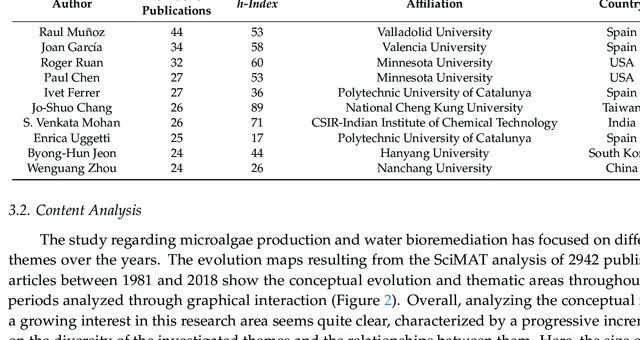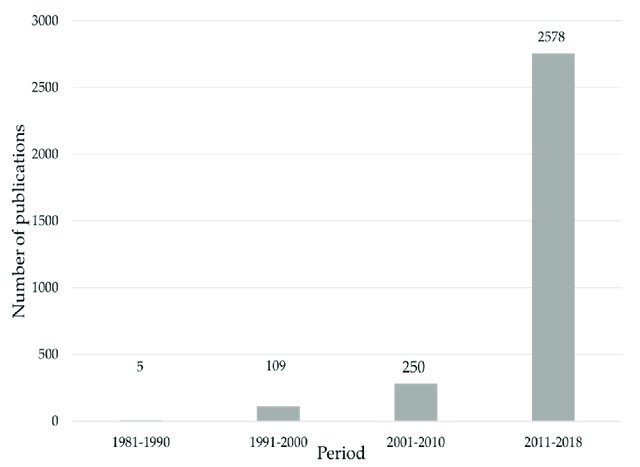The need to reduce costs associated with the production of microalgae biomass has encouraged the coupling of process with wastewater treatment. Emerging pollutants in municipal, industrial, and agricultural wastewaters, ranging from pharmaceuticals to metals, endanger public health and natural resources. The use of microalgae has, in fact, been shown to be an efficient method in water-treatment processes and presents several advantages, such as carbon sequestration, and an opportunity to develop innovative bioproducts with applications to several industries. Using a bibliometric analysis software, SciMAT, a mapping of the research field was performed, analyzing the articles produced between 1981 and 2018, aiming to identifying the hot topics and trends studied until now. The application of microalgae on water bioremediation is an evolving research field that currently focuses on developing efficient and cost-effective treatments methods that also enable the production of add-value products, leading to a blue and circular economy.
Water quality is a fundamental concern of the present century, considering the increasing scarcity of water resources. Degradation of water quality, either caused by anthropogenic activities (e.g., pollution; resources overexploitation) or natural phenomena (e.g., global warming; extreme climatic events) often leads to severe impacts on ecosystems, public health and economic growth, negatively affecting society and environment [
1]. The improvement of water quality is a central issue included in the 2030 Agenda and on Sustainable Development Goals, recognizing the importance of good-quality water for a sustainable development of society and, therefore, the need to globally address this problem.
The discharge of untreated or inadequately treated effluents into rivers, lakes, aquifers and coastal waters supplies the aquatic environment with a myriad of chemical compounds that can impact aquatic organisms directly, by triggering hazardous effects, and indirectly, by changing some physicochemical features of the medium (e.g., oxygen concentration, pH, redox potential and nutrient concentration) [
2,
3].
Contaminants often result from domestic, agricultural and industrial effluents and their physical and chemical compositions differ according to their origins [
4]. The most frequently found are metals [
5], pesticides [
6] and nutrients, such as nitrate [
7] and phosphate [
8]. Moreover, the occurrence of emerging organic and inorganic pollutants, such as microplastics [
9], pharmaceuticals [
10], flame retardants [
11], personal care products [
12], hazardous and noxious substances [
13] has been increasing since conventional wastewater treatment plants (WWTP) are not yet equipped and suitable to remove these new contaminants.
The complexity of effluent composition is increasing as human activities intensify, so it is urgent to develop adequate wastewater treatment processes, which should be easily applicable, effective and eco-friendly, in order to prevent water quality degradation and to protect water resources.
Physicochemical processes alone are proven to be inefficient regarding the treatment of effluents with complex composition [
11]. A possible solution can be the combination of physicochemical and biological treatment technologies aiming at the development of sustainable treatment processes.
Biological treatments often involve the cultivation of microalgae. The capacity of microalgae to remove nutrients [
14], metals [
4], pharmaceuticals [
15,
16], radioactive minerals [
17] or pathogenic organisms [
18] from the medium has been highlighted in literature. Using microalgae to remove pollutants from wastewaters or effluents before their discharge or reutilization is named phycoremediation [
6]. The basic mechanism behind this process is inherent to the algal metabolism, nevertheless, the removal of pollutants will be variable accordingly to different microalgae used and effluents’ characteristics.
Therefore, the design of the cultivation system is a critical parameter for microalgae production in order to achieve optimal growth rates and minimize costs [
19]. For microalgae production, several factors are important to take into account, namely, the biology of the microalgae, cultivation land area, light, nutrient supply, labor, energy, carbon dioxide, pH, temperature and the type of the final product [
20,
21,
22].
Several methodologies of microalgae production have been developed over time, from laboratorial systems under accurate controlled conditions, to open systems in the field under natural, uncontrolled and unpredictable conditions [
20].
Table 1 summarizes the main systems, methods and strategies used. Microalgae are typically cultivated in open or closed culture systems. Furthermore, diverse strategies, namely in batch, continuous and semi-continuous, are applied around the world and which differ mainly on nutrient supply and operation modes [
20].
Due to the high energy demand and operation costs of harvesting processes, solutions were investigated in order to simplify this process [
23]. Therefore, new methods of microalgae cultivation, like the immobilization method on alginate beads and the development of bioreactors that use microalgae biofilm, have emerged and have been coupled to the treatment of wastewater [
24,
25]. Also, the biological interactions among microalgae and bacteria or fungi and microalgae’s ability to naturally flocculate under adverse conditions are under study as means to increase microalgae biomass productivity [
26,
27] and to reduce harvesting [
28], respectively.
Phycoremediation shows great potential to complement traditional wastewater treatment processes. Microalgae cultivation is, thus, a promising approach for WWTP in municipalities or industries, promoting environmentally sustainable effluent treatment, and nutrient and carbon biosequestration; and yields economic benefits–cost reduction and revenue from innovative products originated from microalgae (e.g.,: pigments, enzymes, sugars, and lipids) [
6]. Furthermore, this approach addresses the need to reduce the costs associated with microalgae biomass production [
29], through the recycling of wastewater to obtain microalgal biomass instead of culture medium [
26]. Nowadays, there are already several cases of enterprises worldwide using wastewater sources for microalgae production: United States—
Algae Systems and
Sundine Enterprises,
Inc.; United Kingdom—
I-PHYC; Australia—
Algae Enterprises; Israel—
Aquonos Energy Ltd. [
4,
30].
Microalgae have indeed gained attention from the scientific community and have been a growing subject in research and development (R&D) or research and technology development (R&TD) studies and projects over the last decades, mainly focused on their resilience to grow on different types of wastewaters, performing phycoremediation and promoting decarbonization [
31].
Interest in this field of research is increasing related to the potential of microalgae cultivation for a circular economy, once the microalgal produced biomass can be used and valued in several industries (e.g., food, feed, textile, pharmaceutical, bioplastic, biofuel, biofertilizer and cosmetic [
33,
45,
46]). Nevertheless, cost efficacy of commercialization is still an issue and essential to attract investors to up-scale production, so the technology is still being developed in terms of research and development [
46]. Current research lines focus on four strategic alignments: feedstock, process, products, and market uptake [
30,
47].
This review aims to point out trends and hot topics concerning the use of microalgae in wastewater treatment and to identify potential paths for future research regarding microalgae-based bioremediation. In order to achieve this goal, available literature will be mapped using a bibliometric tool to assess and analyze the topics that attracted more attention among the science community and their evolution through time.
This entry is adapted from the peer-reviewed paper 10.3390/app10051886



